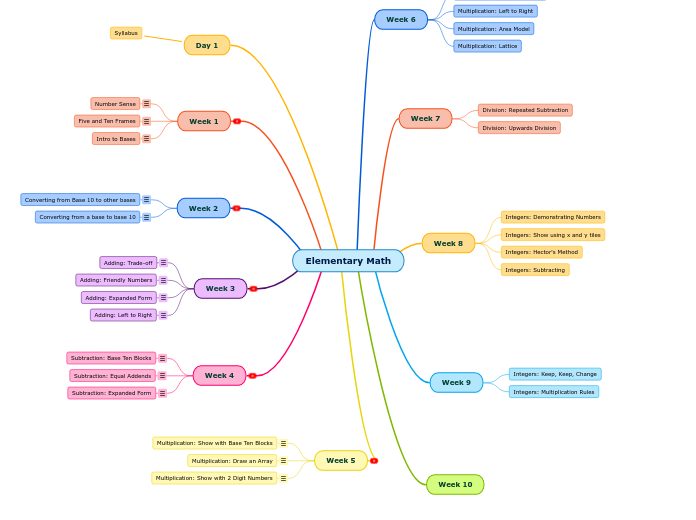
Syllabus
Number Sense
What are the first skills needed to do math?Cardinality, Counting and Skip Counting, Subitizing, More/Less, One-to-One Correspondence
Five and Ten Frames
Five and ten frames are used because we have 5 fingers on each hand. It's why we use base 10.
Intro to Bases
There is more bases other than base 10. Base 10 is simply the one we count in because we have 10 fingers. When counting in other bases, we just count to a different number before grouping them in longs and flats.Ex.: In base 5, we count 1,2,3,4 and then make a long of 5 units. Then 5 longs make a flat.
Converting from Base 10 to other bases
When converting from base 10 to other bases we just want to skip count in the base we are going to. We start in longs and then the left over are units. Then you count the longs and see if there are any flats you can make.Ex.: 38 to base 5I I I I I I I . . . I I I I I I I . . . so this is 1 flat, 2 longs, and 3 unitsthe answer would be 1235
Converting from a base to base 10
When converting from any other base to base 10, we want to count how many units are in the number of that base.1) Draw out the flats, longs, and units in that base2) Count the units in each flat and long and add up how many units there areEx.: Convert 2648 to base 10 I I I I I I I I I I I I I I I I I I I I I I . . . . 64 + 64 + 48 + 4 The answer is 180
Adding: Trade-off
Trade off is when you take numbers units from a number and give them to another to make it end with a 0 so that it is easier to add.Ex.: 37+88 (take 3 units from 88 and give them to 37) 40+85 The answer is 125
Adding: Friendly Numbers
Friendly numbers is like trade off but better. This just makes both numbers that you're adding end with 0s.Ex.: 24+43+76+17 ( take the 6 from 76 and give it to the 24, also 30+50+70+10 take 7 from 17 and give it to 43) 80+80 The answer is 160
Adding: Expanded Form
Expanded form helps reinforce place value. Not very efficient though. Expandable: yes.Ex.: 224+432 200+20+4 + 400+30+2 600+50+6 The answer is 656
Adding: Left to Right
Left to right helps students to not rewrite the original problem to begin working on it. It is like expanded form but a little more efficient, also helps in writing numbers normally.Ex.: 4,266+623 4,000 800 80 + 9 4,889 The answer is 4,889
Subtraction: Base Ten Blocks
When using base ten blocks, you draw out the numbers in flats, longs, and units. You then circle the amount you're subtracting and draw an arrow indicating that you're taking them away. You can also break down flats and longs to take more units as needed.Ex.: 45-13 I I I I . . . . . (underlined is equal to circle in this case) What is left: I I I . . The answer is 32
Subtraction: Equal Addends
Equal addends is when you add the same amount to both all numbers in the equation. You want to add enough units to make the number you're taking away end in a 0 so that it is easier to subtract. This allows to subtract without borrowing.Ex.: 63-35 +5 +5 68-40The answer is 28
Subtraction: Expanded Form
Expanded form in subtraction is basically the same as it is in addition. Ex.: 423-112 400+20+3 - 100+10+2 300+10+1 The answer is 311
Multiplication: Show with Base Ten Blocks
With this, you just group the numbers accordingly and count how many units there are in total. Doesn't have to be organized in neat rows.Ex.: 2(4). . . . (again, underlined means circled in this case)The answer is 8
Multiplication: Draw an Array
In arrays, just group them again, except do this in vertical and horizontal lines. Ex.: 5(3) . . . . . . . . . . . . . . . The answer is 15
Multiplication: Show with 2 Digit Numbers
For this one, you draw out longs and units of the first number vertically on the left, then you do this horizontally for the other number. Then draw lines from both of them and count the units.Ex.: 12(13) (hard to draw on here) _ . . . I(100) (10) (10) (10) . (10) (1) (1) (1) . (10) (1) (1) (1) the answer is 156
Multiplication: Expanded Form
Multiplication: Left to Right
Multiplication: Area Model
Multiplication: Lattice
Division: Repeated Subtraction
Division: Upwards Division
Integers: Demonstrating Numbers
Integers: Show using x and y tiles
Integers: Hector's Method
Integers: Subtracting
Integers: Keep, Keep, Change
Integers: Multiplication Rules